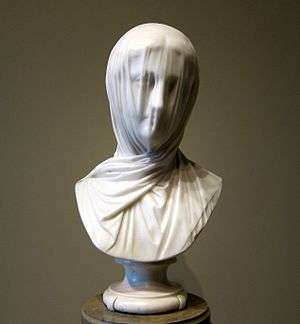The Veiled Nun
| The Veiled Nun | |
|---|---|
 | |
| Artist | Giuseppe Croff |
| Year | 1860 |
| Type | sculpture |
| Medium | marble |
| Dimensions | 20.75 in × 11.00 in × 9.50 in (52.71 cm × 27.94 cm × 24.13 cm) |
| Location | National Gallery of Art, Washington, D.C. |
| Owner | National Gallery of Art |
The Veiled Nun is an 1860 marble bust depicting a female figure. Despite the name, the woman depicted is not a nun. Sculpted by Italian artist Giuseppe Croff, it is considered one of the artist's greatest works. The bust was popular with visitors to the Corcoran Gallery of Art in Washington, D.C. from 1874 until the museum closed in 2014. The bust is now displayed in the National Gallery of Art.
Description
The Veiled Nun is a 20.75 in (52.7 cm) tall marble bust depicting a female figure wearing a veil.[1][2][3] The fine details give the illusion of the veil being opaque and transparent.[4] Because of the woman's stylish coiffure and embroidered veil, she is not a nun, but rather a woman of means or an allegorical figure.[2][3][4] According to photographer David Finn and art historian Susan Joy Slack, "the mysterious nature of the work, its inward focus, and the relative 'foreignness' of veiled figures to American museumgoers caused early visitors to refer to her as a nun, and the appellation has remained."[4] The bust has been described as a "fine example of a detailed rendering of texture and form", a "tour de force of carving" and "carved to make stone look like silk".[3][5][6]
History
Artist
Paintings and sculptures depicting veiled women were popular during the late 19th-century.[2] The Veiled Nun was sculpted in 1860 by Italian artist Giuseppe Croff (1810–1869).[2][4] Croff attended the Accademia di Brera in Milan where he lived and worked, though he would later spend much of his career near Lake Como.[4][5] His teachers included artists Camillo Pacetti and Pompeo Marchesi.[5] Croff's other works include a sculpture of Saint John of God on the exterior of the Milan Cathedral, a sculpture of a seated nude girl for Emperor Ferdinand I of Austria and sculptures displayed at the 1853 Exhibition of the Industry of All Nations (World's Fair).[4][7]
Acquisition and display
The bust was purchased for $300 in 1873[lower-alpha 1] by American banker and art collector William Wilson Corcoran during a visit to Rome.[1] He gifted the artwork to his museum, the Corcoran Gallery of Art (the current Renwick Gallery building), where it was prominently featured in the Octagon Room during the January 1874 opening exhibition.[1][8] The bust would become one of the most popular artworks throughout its time at the museum.[3][5][9] Following the Corcoran's dissolution in 2014, The Veiled Nun and 17,000 other works of art worth $2 billion were donated to the National Gallery of Art.[1][10]
References
Notes
Citations
- 1 2 3 4 5 "Veiled Bust ("The Veiled Nun")". National Gallery of Art. Retrieved January 30, 2017.
- 1 2 3 4 5 "The Veiled Nun". The Corcoran. Retrieved January 30, 2017.
- 1 2 3 4 5 Richard, Paul (March 31, 2002). ""The Veiled Nun" is many things". The Washington Post. Retrieved January 30, 2017 – via HighBeam Research. (Subscription required (help)).
- 1 2 3 4 5 6 Finn, David; Slack, Susan Joy (2002). Sculpture at the Corcoran: Photographs by David Finn. New York: Ruder Finn Press. p. 39. ISBN 9780972011914.
- 1 2 3 4 "Giuseppe Croff". Sotheby's. Retrieved January 30, 2017.
- ↑ Judkis, Maura (June 26, 2014). "The Corcoran Gallery's hidden gems". The Washington Post. Retrieved January 30, 2017.
- ↑ The Plough, the Loom, and the Anvil, Volume 6. Philadelphia: J.S. Skinner & Son. 1853. pp. 238–239. OCLC 1762489.
- ↑ "Dedicated to Art". National Republican. January 12, 1874. Retrieved January 30, 2017.
- ↑ Judkis, Maura (September 28, 2014). "'An empty tomb': Former Corcoran staffers hold 'funeral' for museum". The Washington Post. Retrieved January 30, 2017.
- ↑ Montgomery, David (February 19, 2014). "Corcoran Gallery of Art and College to split apart, partnering with National Gallery, GWU". The Washington Post. Retrieved January 30, 2017.
External links
